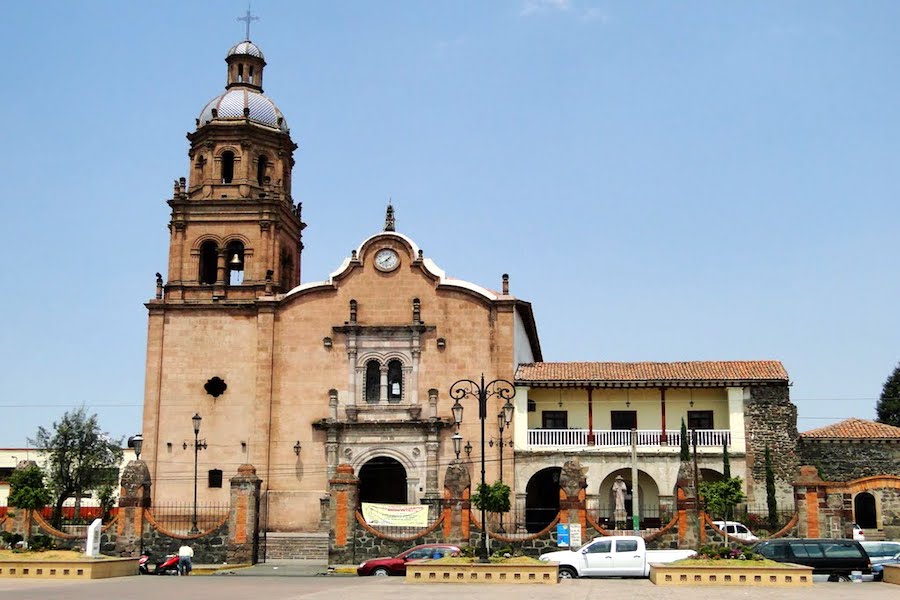The word “Pátzcuaro” means “foundation place” in Purhépecha dialect, it was also called “Petatzecua”, which in turn means “stone or origin of man”, characterized by “Cúes” or temples that make no reference to the streets through which we can now stroll, but to the ruins of an ancient and unknown civilization that in turn were encountered by the prehispanic founders of the city.
Pátzcuaro lies in what once was the independent kingdom of Michoacán, whose capital was Naranxan before the thirteenth century. Later Tzintzuntzan, meaning “humming bird place” became the capital and was repopulated by the illustrious Vasco de Quiroga in the year 1540, after the devastation caused by Nuño de Guzmán, an spaniard conqueror. This city boasts a coat of arms, featuring a distinctive drape of blue and white, granted by king Carlos V in 1553. If you pronounce the word “Tzintzuntzan” you can easily imagine its meaning. Many hummingbirds can be seen in the area, especially early in the morning.
Because the Purhépecha culture lacks a written language, its origin and history remain somewhat a mystery. Its stories, legends, customs and even the dialect pass from one generation to the next through an oral tradition transmitted by the old men, who hold a very special place in its social schema.
Of this culture, several theories have developed with respect to its origin: there are those who will say that this race comes from a branch of the Aztecs. There are others who relate them to the Incas, stating that they arrived in this region from Perú via the river Santiago in Nayarit and proceeding through the present state of Jalisco. According to another version, this area was inhabited by the pre-“Tarascos”, a word that means “Son of God”, or “of the god Tares” (?).
There exists another -more accepted- theory about the name now given to this native race (Tarascan): this states that the name Purhépecha was used until the beginning of the sixteenth century, and that the word “tarasco” is a corruption of the word “tarascue” which in the native dialect means “brother-in-law”. This term was adopted by both the natives and Spaniards as result of the relationships of the Spaniards with the women of the region, and now it is used to designate the inhabitants of the old Purhépecha’s empire. Nevertheless, whichever is the correct version, the reality is that the natives of the region proudly call themselves and their language Purhépecha.
We know that during the fourteenth and fifteenth centuries, the Purhépecha empire was a powerful and prosperous civilization whose influence spread as far as what now are the states of Jalisco, Guanajuato, Colima and Guerrero. Much attention has been paid to Cortés and to the Aztecs, but it should be remembered that the Purhépechas had already discovered iron and that they were the only people that the Aztecs or Mexicas were unable to defeat in the many battles they fought (except when they were allied with the Spaniards).
Even so, according to history, 30, 000 Aztec warriors were taken prisoner by the Purhépechas in the battle of Taximaroa, (today the city of Hidalgo) against the armies of Cristóbal de Olid, a cruel Spaniard captain which finally defeats Tanganxhúan II, one of the lasts Purepecha’s emperors and then, according to the choice of each prisoner, each was sacrificed or taken as a slave by his captors.
Pátzcuaro was founded in 1324 by the king Curátame and reconstructed in 1372 by his descendant Tariácuri. As in the rest of Michoacán, this region did not escape atrocities, committed first by Cristóbal de Olid and later by the bloodthirsty Nuño de Guzmán, a captain in Hernán Cortés’ army. According to Guzmán’s own documents, „…they (the Purhépecha) are men of inferior race whom Cortés wants to get rid of…”.
In 1528, a small band of mercenaries headed by Nuño de Guzmán was about to be sent back to Spain due to the discontent that his atrocities were causing his government. He then decided to make a cruel and unnecessary attempt at conquering the west of México. The fall and the arrest of these men by the Spanish authorities in no way erases the chaos and destruction they caused in Michoacán. Due to the burning, violation, assassination and enslavement of a peaceful and innocent people, Nuño de Guzmán is remembered sadly as the symbol of malicious invasion and the power of a conqueror without flag, creed or race, who believes in extreme force and violence as the only means of persuasion.
In a short time, the grand and powerful Purhépecha nation was completely devastated. The culture was destroyed, its temples, houses and fields sacked, and the people who escaped death and torture were dispersed throughout the mountains of Michoacán. Had it not been for the effort of one man whose ideals, good judgment and ability to put into practice the morals that he preached, it is doubtful that the Purhépechas would have survived.
This man was don Vasco de Quiroga, who arrived in México in 1531, and about seven years later became the first bishop of Michoacán.














